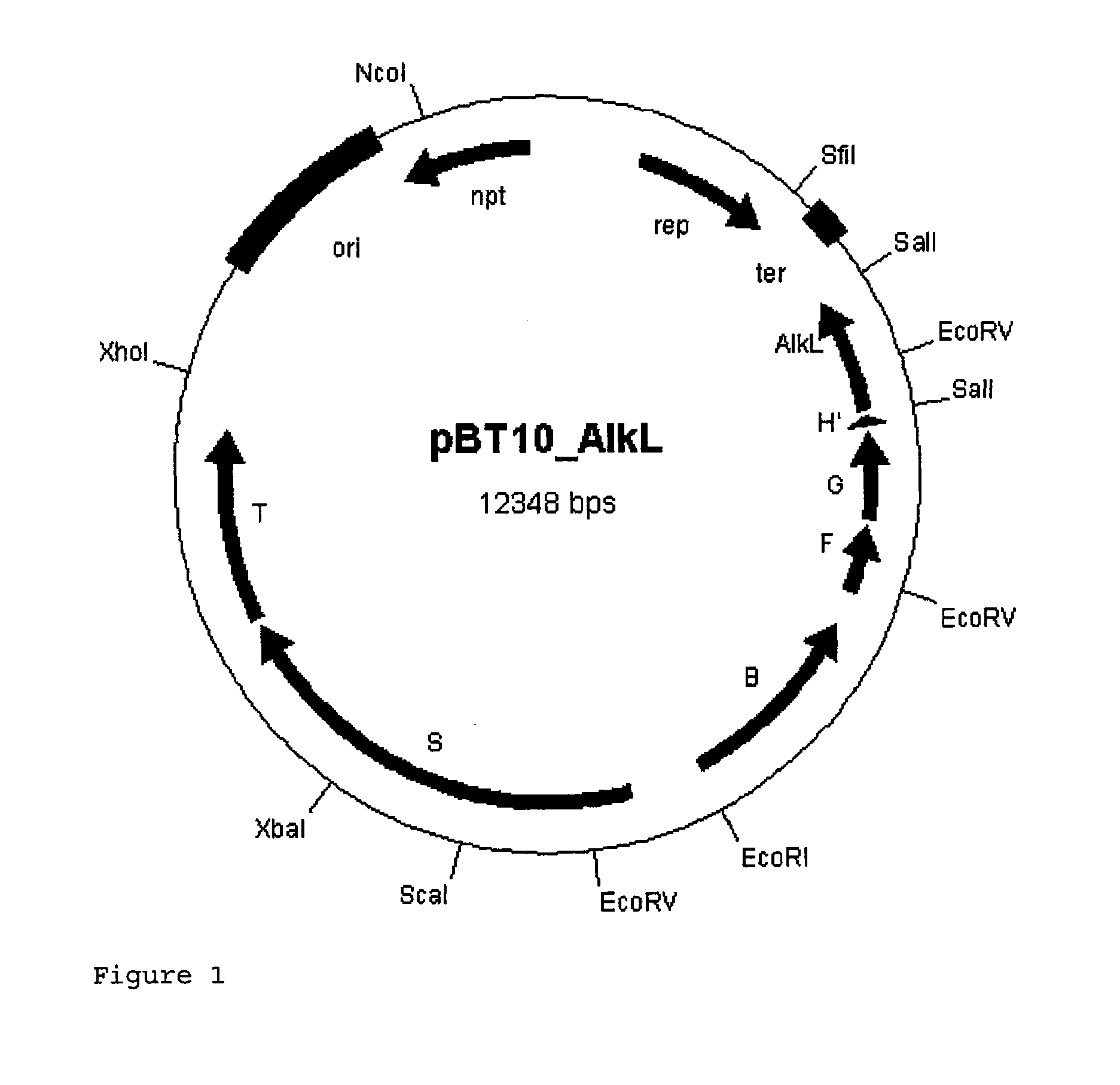Biocatalytic oxidation process with alkl gene product
a biocatalytic and gene product technology, applied in the direction of oxidoreductases, biochemical apparatus and processes, enzymes, etc., can solve the problems of unnecessarily co-synthesized alk gene products containing unwanted enzyme activities, reducing performance, and high demands on the metabolic capacity of the host by synthesis of further alk gene products
- Summary
- Abstract
- Description
- Claims
- Application Information
AI Technical Summary
Benefits of technology
Problems solved by technology
Method used
Image
Examples
example 1
Expression Vector for the AlkBGT Alkane Hydroxylase System from Pseudomonas putida GPo1 with alkL
[0072]In a further approach, the alkL gene was cloned into the alkBFG operon in a targeted manner in order to be able to synthesize it together with the minimum set of enzymes required for the oxidation.
[0073]For this purpose, the alkL gene from pGEc47 (Eggink et al., 1987, J Biol Chem 262, 17712-17718) was amplified by PCR.
[0074]The primers P1 and P2 used for this purpose, for cloning into the SalI restriction cutting site of the plasmid pBT10, likewise contain SalI restriction cutting sites outside the target sequence. Furthermore, a stop codon was incorporated into the forward primer P1 downstream of the SalI restriction cutting site in order to terminate possible translation of the alkH residues.
(Seq ID No. 6)P1ACGCGTCGACCTGTAACGACAACAAAACGAGGGTAG(Seq ID No. 7)P2ACGCGTCGACCTGCGACAGTGACAGACCTG
[0075]For the amplification, the Finnzyme Phusion polymerase (New England Biolabs) was used.
[...
example 2
Conversion of Lauric Acid, Methyl Ester to ω-Hydroxylauric Acid, Methyl Ester
[0091]For the biotransformation, the plasmids pBT10 or pBT10_alkL were transformed into the chemically competent strain E. coli. W3110 by heat shock at 42° C. for 2 min (Hanahan D., DNA cloning: A practical approach. IRL Press, Oxford, 109-135). For the synthesis of hydroxylauric acid, methyl ester, E. coli W3110-pBT10 and W3110-pBT10_alkL were cultured over-night at 30° C. and 180 rpm in 100 ml of M9 medium (Na2HPO46 g / l, KH2PO43 g / l, NaCl 0.5 g / l, NH4Cl 1 g / l, 2 mM MgSO4, 0.1 mM CaCl2, 0.5% glucose) containing 30 mg / l of kanamycin and harvested by centrifugation. Some of the biomass was resuspended under sterile conditions in 250 ml of M9 medium containing 0.5% glucose and 30 mg / l of kanamycin to give an OD450=0.2 and further cultured in the shaking flask at 30° C. and 180 rpm. Expression of the alk genes was induced after a growth time of 4 h by adding 0.025% (v / v) of dicyclo-propyl ketone and the cultur...
PUM
| Property | Measurement | Unit |
|---|---|---|
| concentration | aaaaa | aaaaa |
| growth time | aaaaa | aaaaa |
| pH | aaaaa | aaaaa |
Abstract
Description
Claims
Application Information
 Login to View More
Login to View More - R&D
- Intellectual Property
- Life Sciences
- Materials
- Tech Scout
- Unparalleled Data Quality
- Higher Quality Content
- 60% Fewer Hallucinations
Browse by: Latest US Patents, China's latest patents, Technical Efficacy Thesaurus, Application Domain, Technology Topic, Popular Technical Reports.
© 2025 PatSnap. All rights reserved.Legal|Privacy policy|Modern Slavery Act Transparency Statement|Sitemap|About US| Contact US: help@patsnap.com

